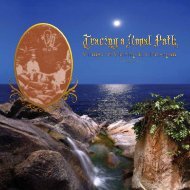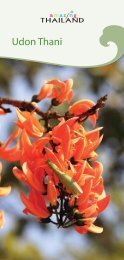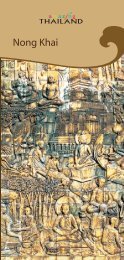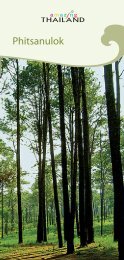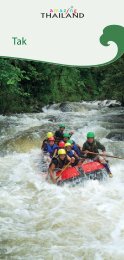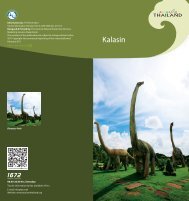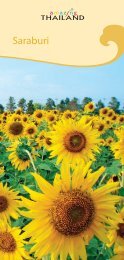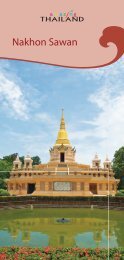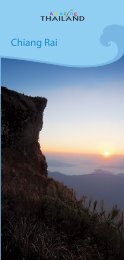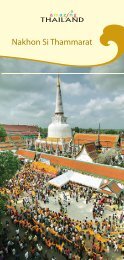Sukhothai - TourismThailand.org - Tourism Authority of Thailand
Sukhothai - TourismThailand.org - Tourism Authority of Thailand
Sukhothai - TourismThailand.org - Tourism Authority of Thailand
You also want an ePaper? Increase the reach of your titles
YUMPU automatically turns print PDFs into web optimized ePapers that Google loves.
16<br />
Wat Si Sawai������������� Situated 350 metres south <strong>of</strong> Wat Mahathat<br />
is Wat Si Sawai. The highlight <strong>of</strong> this temple is the 3 Lop Buri-style<br />
stupas. These corn-shaped stupas are quite slim with certain parts <strong>of</strong> its<br />
stucco relief décor on a low base resembling the pattern on the bone<br />
china from the Yuan Dynasty. There is evidence that this temple was<br />
originally a Hindu shrine. During an excavation, a lintel showing the<br />
reclining Vishnu, as well as, fragments <strong>of</strong> images <strong>of</strong> divinities and <strong>of</strong> a<br />
Sivalinga were found. The shrine was later converted into a Buddhist<br />
temple by adding a wihan in front.<br />
Outside the City Wall<br />
Sites in the North<br />
Tourist Service Centre ��������������������������������������������<br />
���������Situated in front <strong>of</strong> Wat Phra Phai Luang, this tourist centre in<br />
traditional Thai architecture <strong>of</strong> the <strong>Sukhothai</strong> style provides information<br />
for tourists visiting the <strong>Sukhothai</strong> Historical Park. A model <strong>of</strong> the old<br />
city <strong>of</strong> <strong>Sukhothai</strong> is also on exhibition here. To get the overview picture<br />
<strong>of</strong> this place, this is an ideal spot to start.<br />
Ruins <strong>of</strong> the Old Celadon Factory (Thuriang Kilns) ������<br />
������������������������������������������<br />
The Thuriang Kilns, which may have<br />
been founded in the late 13 th century, are situated near the ‘Mae Chon’<br />
city moat near Wat Phra Phai Luang. This is a site where <strong>Sukhothai</strong><br />
celadons were made. So far, 49 kilns have been discovered in 3 di�erent<br />
areas: 37 lie north <strong>of</strong> the moat, 9 to the south, near the city wall, and 3<br />
to the east. The vaulted brick kilns measure 1.5 – 2 metres wide and 4.5<br />
metres long. The ceramic wares found here are generally large bowls<br />
and jars; they have a matt yellowish grey glaze, and a design, usually<br />
<strong>of</strong> a �ower, a �sh, or a whirling circle, painted in black.<br />
Wat Phra Phai Luang ��������������� A large temple, Wat Phra<br />
Phai Luang is the second most important temple in <strong>Sukhothai</strong> – next<br />
to Wat Mahathat. Its rectangular plan is surrounded by 3-line moats,<br />
with Khu Mae Chon forming the outermost enclosure. It is believed<br />
that Wat Phra Phai Luang may have been the centre <strong>of</strong> the original city.<br />
The most prominent feature here is the 3 main laterite prangs, which<br />
are in the Bayon style <strong>of</strong> Khmer art dating back to the period <strong>of</strong> King<br />
Jayavarman VII. A mondop in front contains stucco Buddha images in<br />
4 postures: sitting, reclining, standing, and walking.




